Autocar India and OLX Autos team up to bring you the second edition of the most comprehensive Resale Value Study.
After a successful first edition in 2021, we partnered with OLX Autos once again for the second edition of our detailed pre-owned car study. The objective of the study is to find out how different models across brands and segments fare in the pre-owned market.
Commenting on the study, Amit Kumar, CEO, OLX Group India, said, “The pre-owned car market has been growing steadily, and, similar to the new car market, has made a strong recovery post the pandemic. Consumers, including first-time buyers, are increasingly preferring to buy a pre-owned car, as the quality, availability and purchase experience becomes easy and transparent, besides providing value for money. The Residual Value Study that we launched with Autocar last year aims to provide an almanac of key insights to consumers that can be very helpful in making well-informed car buying decisions.”
Prices and demand in the pre-owned market are also driven by the waiting periods for new cars, which stretch to months and even years in some cases. Also, to meet stringent safety and emission norms, prices of new cars have gone up significantly, thus having a corresponding effect on used car prices.
OLX Autos builds advanced trading platforms for buying and selling second-hand cars. It combines online and offline services in a simple one-stop solution, bringing convenience, safety, and peace of mind to car buyers and sellers alike, across nine countries and four continents.
OLX Autos operates 550+ inspection centres across Asia, Europe and the Americas, and online trading platforms for people to buy and sell cars. Over 65,000 vehicles are inspected globally every month. The data for the study is gleaned from these transactions and our methodology is as follows:
- OLX Autos provided us actual transactional data of all models sold up to September 30, 2022, through their various platforms across five cities – Mumbai, Delhi-NCR, Kolkata, Bengaluru and Chennai.
- For this study, we take into consideration models that are two to five years old, hence only cars manufactured between 2017 and 2020 make the cut.
- Now-discontinued models or variants have been excluded from this study.
- The sample size is smaller than last year, hence, certain models marked in BLUE are the ones that have limited data.
- The data is presented for each fuel and transmission type separately. In case of multiple engine options of the same fuel type, prices have been merged and averaged, as have those of the trims and variants.
- Depreciation is the difference between average resale price in 2022 and its average on-road price in its manufactured year.
Budget hatchbacks
With the Datsun Redi-go exiting this space post the company’s announcement to shut down the brand, the entry-level segment is down to three models, two of which are from the Maruti stable – Alto and S-Presso – and the third is the popular Renault Kwid.
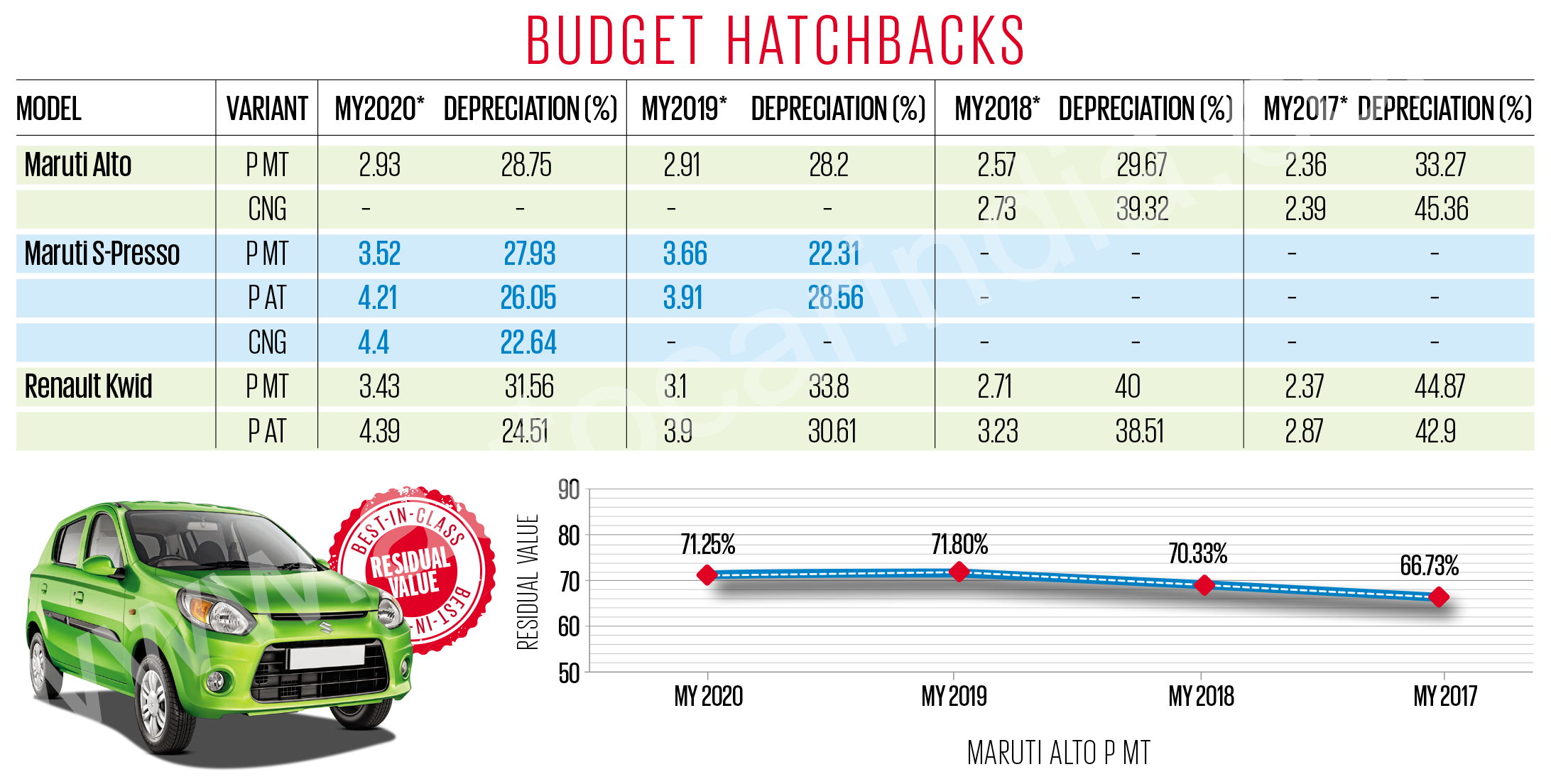
Maruti Suzuki Alto
The Alto’s solid brand equity and its strengths, like its compact size and supreme reliability, have made this one of the most loved hatchbacks in the country for over two decades now. And owing to its popularity, this Maruti still manages to secure its spot in the top 10 bestselling cars month after month. What’s equally impressive is its demand in the used car market. Despite being available in abundance, prices don’t seem to depreciate significantly.
Maruti Suzuki S-Presso
In its short stint, the S-Presso has made a strong impression on the sales charts. Interestingly, the average on-road price of an S-Presso is lower than the Kwid, but data indicates that buyers are paying a premium for the Maruti. Although sales data in the used car market is limited, it appears that the S-Presso CNG holds its value the best in the segment.
Renault Kwid
With its crossover-esque design and its attractive packaging, the Renault Kwid has certainly caught the fancy of buyers in the new and used car market alike. The average selling price of the Kwid is higher than the Alto’s. However, as far as depreciation goes, the Kwid loses value at a faster rate than the two Marutis here.
Hatchbacks
It is safe to say that the hatchback segment continues to be dominated by Maruti, with four out of seven models on sale – WagonR, Celerio, Ignis and Swift. Mahindra, Hyundai and Tata are represented by KUV100, Grand i10 Nios and Tiago, respectively. Hyundai has pulled the plug on the Santro, Datsun is no more and Ford has pulled the plug on its India operations, hence, neither the GO nor the Figo make it to the list. We take a look at how the rest fared in the pre-owned market.
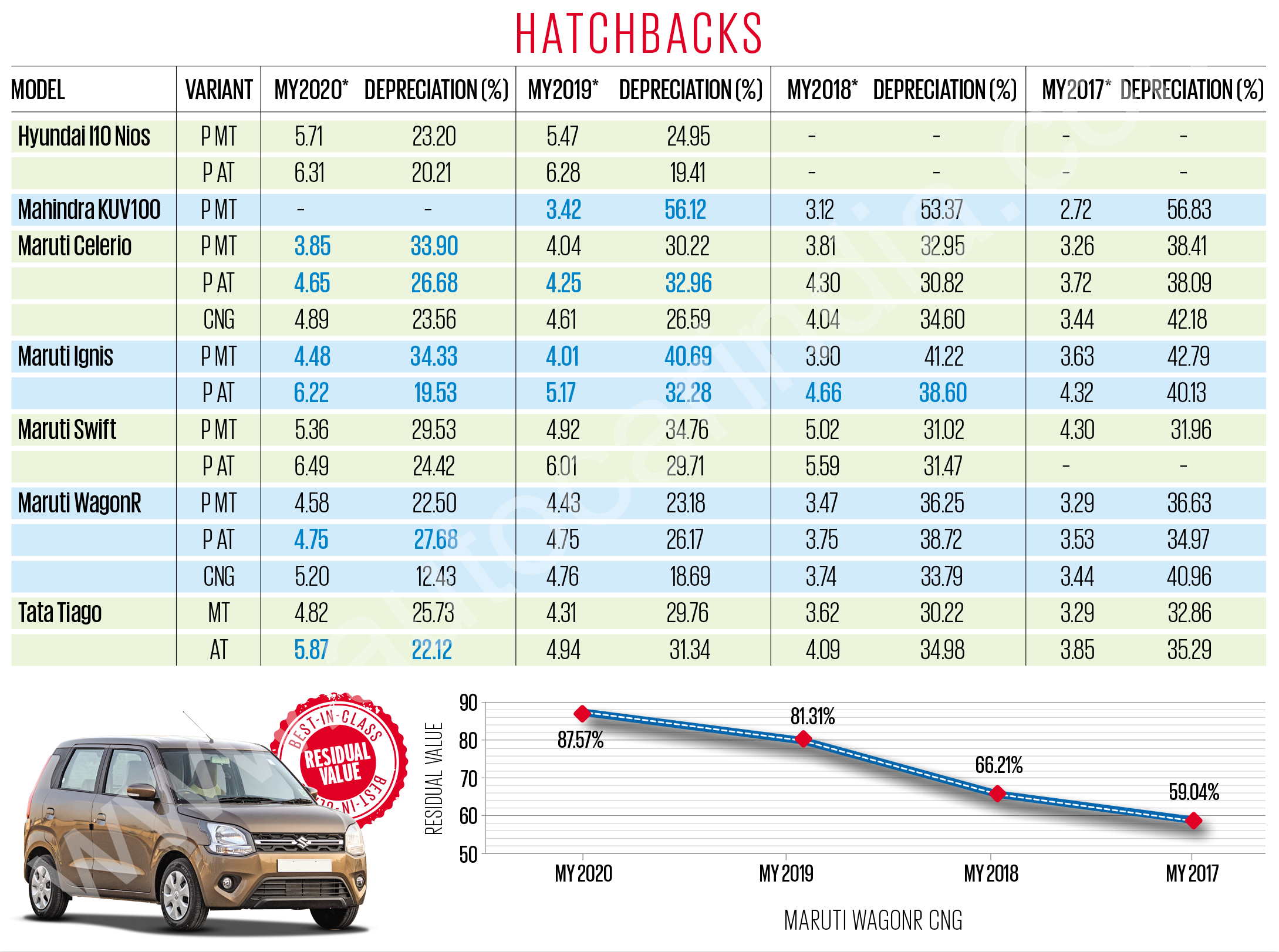
Hyundai Grand i10 Nios
The successor to the very popular Grand i10 hatchback, the Nios is a rather plush hatchback that checks most boxes for buyers in this segment. It is one of Hyundai’s strong sellers and its demand in the pre-owned segment is equally strong, with its depreciation among the lowest in the segment; the petrol-AMT variants hold their value better than the rest.
Mahindra KUV100
Mahindra cleaned up the KUV100’s styling with the introduction of the NXT version in 2018, but the design remains a deal maker or breaker for most. The KUV also happens to be the only car here offered as a 6-seater, with a three-plus-three seating configuration. Like in the new car space, demand for the KUV100 in the pre-owned space seems low and it loses over half its value in four to five years, with petrol-manual examples exchanging hands for under Rs 3 lakh.
Maruti Suzuki Celerio
The model in question is the outgoing generation of the Celerio, which made its debut in 2014 and is the oldest car in the segment. Its depreciation is higher than its more modern rivals, particularly for the petrol-manual versions. However, like the WagonR, its CNG variants hold their value better.
Maruti Suzuki Ignis
The funky and youthful Ignis is a car that’ll divide opinions due to its styling – some will love it, others won’t. And it is this reason, as well as its premium positioning, that this Maruti has had a lukewarm response in the market, both new and used. The Ignis, in its petrol-manual guise, loses its value quicker than most other hatchbacks, although the petrol-AMT seems to hold its value better.
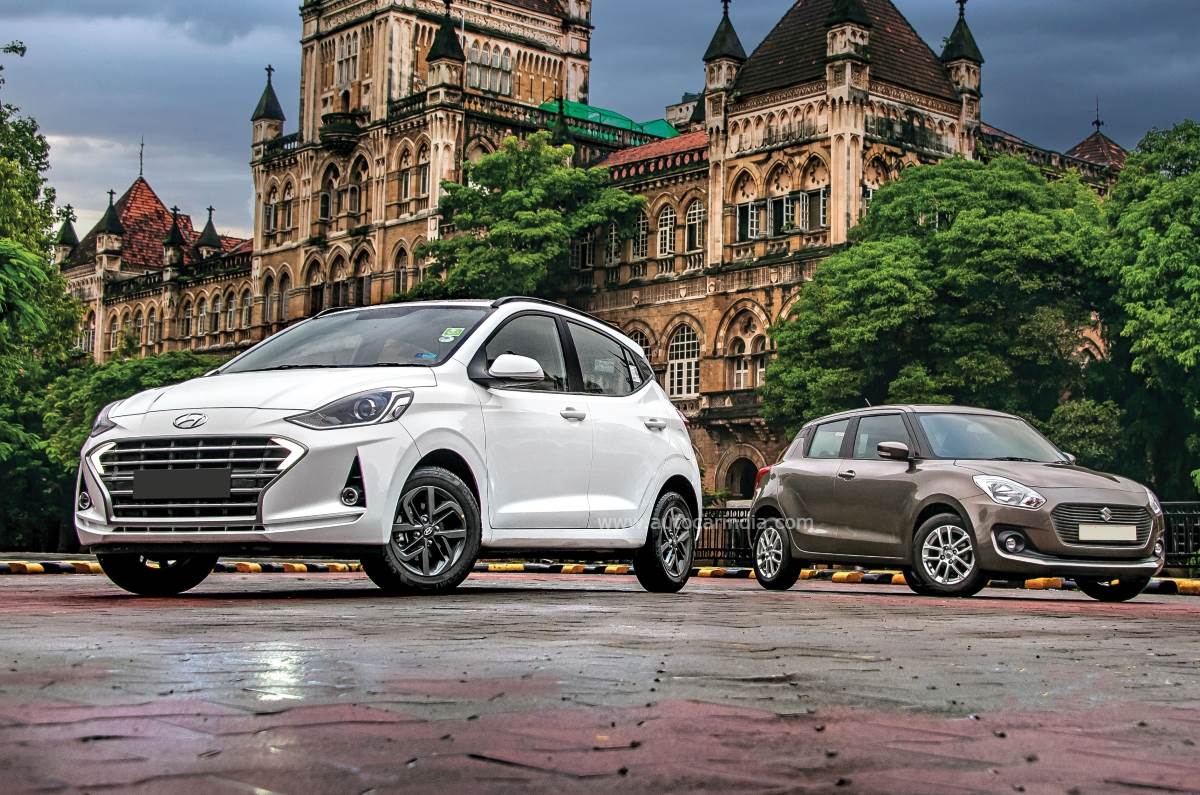
Maruti Suzuki Swift
The formidable Swift is the priciest of the lot in the new car space. However, despite all its strengths and its strong demand in the new car market, buyers in the used car space are paying lower prices for a Swift compared to a Hyundai i10 Nios. Hence, Swift owners bear the brunt of a higher depreciation.
Maruti Suzuki WagonR
Maruti launched the new-generation WagonR in 2018, which is bigger, more spacious and more modern than the version it replaces. Interestingly, OLX’s used car data reveals that the new 2018 petrol iterations depreciate as much as older 2017 versions. Of course, the 2018’s averageselling price is higher, because of the corresponding higher new car prices. Another trend revealed here is CNG variants hold their value far better than their petrol counterparts and are slowest to depreciate across the entire segment.
Tata Tiago
Tata’s contemporary Tiago hatchback had been driving sales for the company till its SUVs took the reins. Demand in the used car space is quite strong too, with the Tiago depicting a gradual depreciation graph for models that are two to five years old.
Premium hatchbacks
The premium hatchback segment has seen some radical changes, with the new Hyundai i20, new Maruti Baleno and new Toyota Glanza replacing their respective older models. However, for this study, we’ll be considering their outgoing generations. Making its debut in this study is the relatively new Tata Altroz, while the Polo has been left out as Volkswagen retired this hatchback after it served for over a decade.
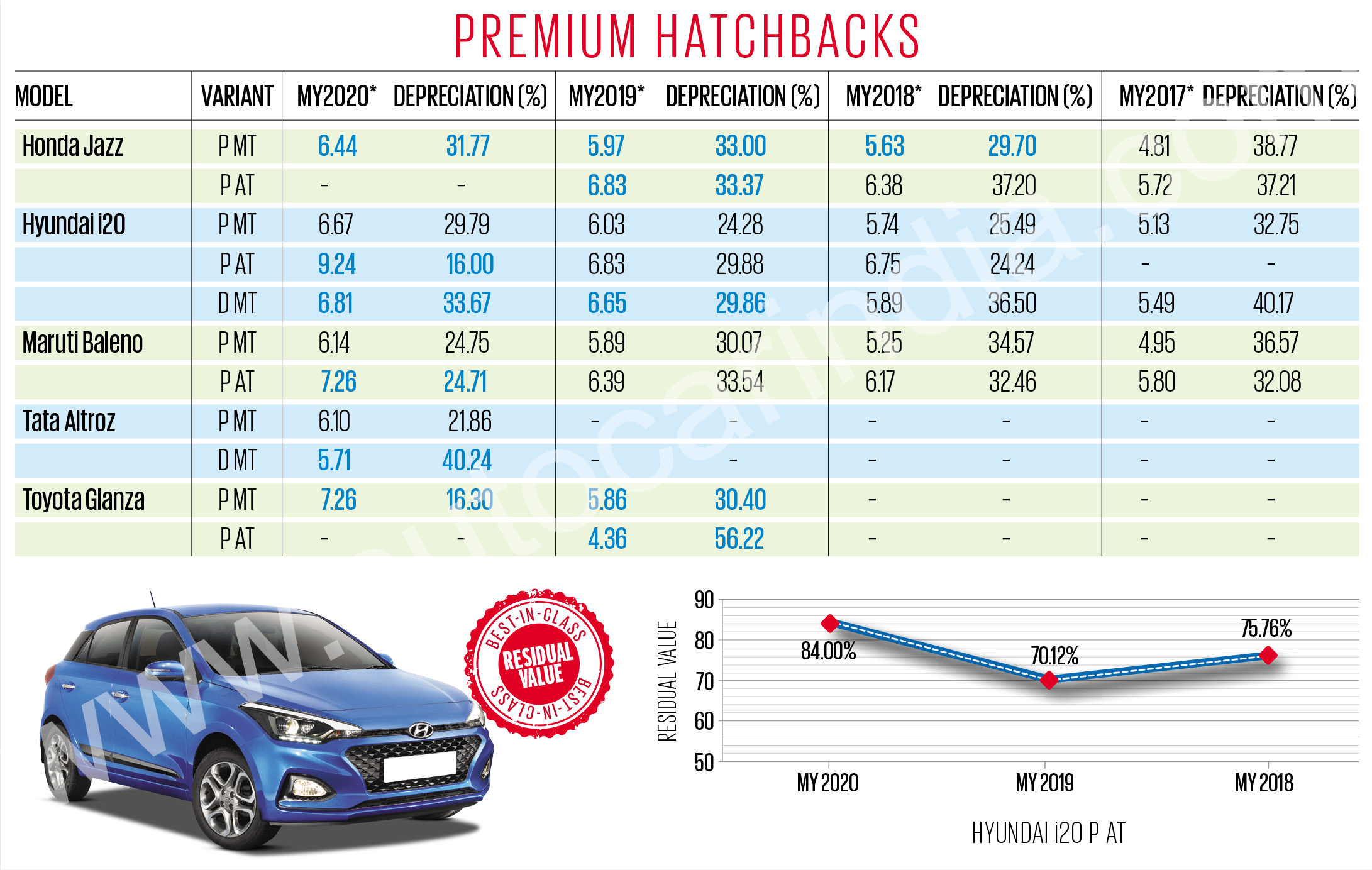
Honda Jazz
The Jazz is the oldest car here and cumulative sales are much lower than rivals. Depreciation for the Jazz is the highest, making it very good value in the pre-owned space, especially considering that its new car price is at the higher end of the segment. However, finding two- and three-year-old cars in the used car segment can be challenging.
Hyundai i20
Hyundai’s i20 is the most expensive hatchback in India, but it is a very popular model in the new car market, which means there are plenty of pre-owned i20s available in all iterations – petrol, automatic and diesel. However, the new car, with its strong brand value, commands a higher resale price than its rivals.
Maruti Suzuki Baleno
The Baleno is the bestselling premium hatchback in the market, hence, used examples are found in abundance. Our data reveals that two-year-old petrol Balenos lose one-fourth of their value, but from thereon, the depreciation graph is rather flat.

Honda Jazz depreciates the most; i20 is priciest.
Toyota Glanza
The Glanza is a rebadged Baleno but it sells in much lesser numbers than the Maruti. As a result, examples in the used car market are few and far between. With the limited data available, it indicates that the Glanza holds its value better than the Maruti, which could be because of its exclusivity as well as its more premium Toyota badge. However, given the smaller sample size, this should be treated as indicative.
Tata Altroz
Apart from its stunning design, the Altroz has tasted success in the market due to its value proposition. What’s interesting is that the average price of a used petrol-manual example is the least, and its depreciation is also the lowest. The diesel, on the other hand, seems to be taking a much larger hit, and even though data is limited, the study reveals that some diesel examples are selling for less than a petrol version.
Compact sedans
A segment born due to legislation, the compact sedan space was once the fastest growing in the country, with manufacturers like Tata, Maruti, Hyundai, Honda, Ford, Volkswagen and Mahindra specially developing cars to grab a piece of this market. However, with changing demand trends, this segment now plays second fiddle to SUVs, due to the latter’s ever increasing popularity. As a result, three out of the seven players have bowed out, clearing the field for the Tata Tigor, Maruti Dzire, Hyundai Aura and Honda Amaze. But how do they perform in the pre-owned market?

Honda Amaze
What our data indicates is that buyers are paying a higher average price for the Amaze than the Maruti Dzire in the used car market. Diesel offerings in the used car market are hard to come by, indicating that owners are holding on to their cars longer, potentially due to the lack of diesel options available in the market today.
Hyundai Aura
The Aura replaces the Xcent compact sedan. However, due to limited used car data, it is difficult to gauge its performance in the pre-owned market, even though it appears to depreciate the slowest across variants.

Honda Amaze commands a better resale price than the Maruti Dzire.
Maruti Suzuki Dzire
The Maruti Suzuki Dzire is the bestseller, outselling all its rivals combined. Its sales performance in the used car space is equally impressive. Not only do five-year-old models depreciate the least compared to rivals, its graph appears the most consistent. Unlike the case with most other models, automated manual transmission (AMT) variants lose their value at a higher rate than their manual counterparts.
Tata Tigor
In its petrol avatar, Tata’s stylish compact sedan hasn’t managed to achieve favourable sales, hence examples in the pre-owned market are few and far between. Our data indicates that five-year-old cars are easier to find, and AMT (auto) variants command a higher price and depreciate slower than their manual counterparts.
Midsize sedans
This is another segment that’s borne the brunt of the rising popularity of SUVs. With Volkswagen and Skoda discontinuing their Vento and Rapid sedans for their respective all-new offerings – the Virtus and Slavia, launched in 2022 – the midsize sedan field (for this study) is now occupied by the Honda City, Maruti Ciaz and Hyundai Verna.

Honda City
Honda’s oldest nameplate in India, the City is the go-to car for someone looking at a well-rounded midsize sedan. In the second-hand space, the City petrol seems to be a popular choice, whereas the diesel versions are hard to find, and their resale values seem to be lower than their petrol counterparts. Honda introduced a new-generation City in 2020, which seems to be commanding the highest residual value in terms of price. However, its depreciation seems to be similar to the Hyundai Verna and higher than the Maruti Ciaz.
Hyundai Verna
With multiple powertrain choices, the Hyundai Verna has a broad appeal and is also relatively more affordable than the Honda City. Five-year-old used examples seem to hold their value well and are slow to depreciate. Due to limited data on newer examples, it is difficult to gauge the Verna’s performance in the used car market.

Despite higher depreciation, the Honda City is still the most expensive used sedan.
Maruti Suzuki Ciaz
The Ciaz is the oldest car in this segment (others are newer-gen models), and post its midlife makeover in 2018, it continues to keep the cash registers ringing at Maruti. Not only is it the most affordable sedan to buy in the new car market, prices in the used car market are also the lowest compared to the other two – you can source five-year-old petrol-manual units for under Rs 6 lakh, while automatics are available for under Rs 7 lakh.
Compact SUVs
It is still one of the fastest growing segments and one that’s the most densely populated, with no less than six manufacturers and nine models on offer. The company with the most offerings in this space is Mahindra, with three compact SUVs – XUV300, Bolero and TUV300. While Mahindra has dropped the TUV300 nameplate – in 2021 – the SUV was rebranded as the ‘Bolero Neo’. The oldest player in this space, Ford, has ended its India operations, and as a result, two of its contenders from last year, EcoSport and Freestyle, don’t make it to this year’s study.

Honda WR-V
Honda’s cross-hatchback comes with petrol and diesel engine options, but both are paired only with a manual gearbox. However, its SUV-esque appeal and the fact that it was the most affordable car of its time to be available with a sunroof helped its case. Interestingly, five-year-old models are selling at higher average prices than a comparable Nexon or Brezza, and the resale price of this Honda seems stronger than Tata across the board.
Hyundai Venue
In most cases, rising new car prices have a corresponding effect on used prices, but that isn’t the case with the Hyundai Venue. On the contrary, despite new car prices witnessing a steep ascent, average selling prices of two- and three-year-old examples of the Venue in the used car market have remained rather consistent.
Kia Sonet
Kia’s first compact SUV, the Sonet, is the newest car in this segment and the most feature-packed as well. Buyers have formed a beeline to get their hands on the Sonet, but supply constraints have resulted in waiting periods that stretch over months. This long waiting period plays its role in boosting its used prices, and as a result, the Sonet is among the priciest cars to buy used. While a used Sonet isn’t good value for money, it’s a way of getting your hands on one, if you don’t have the patience to wait for a brand-new car.
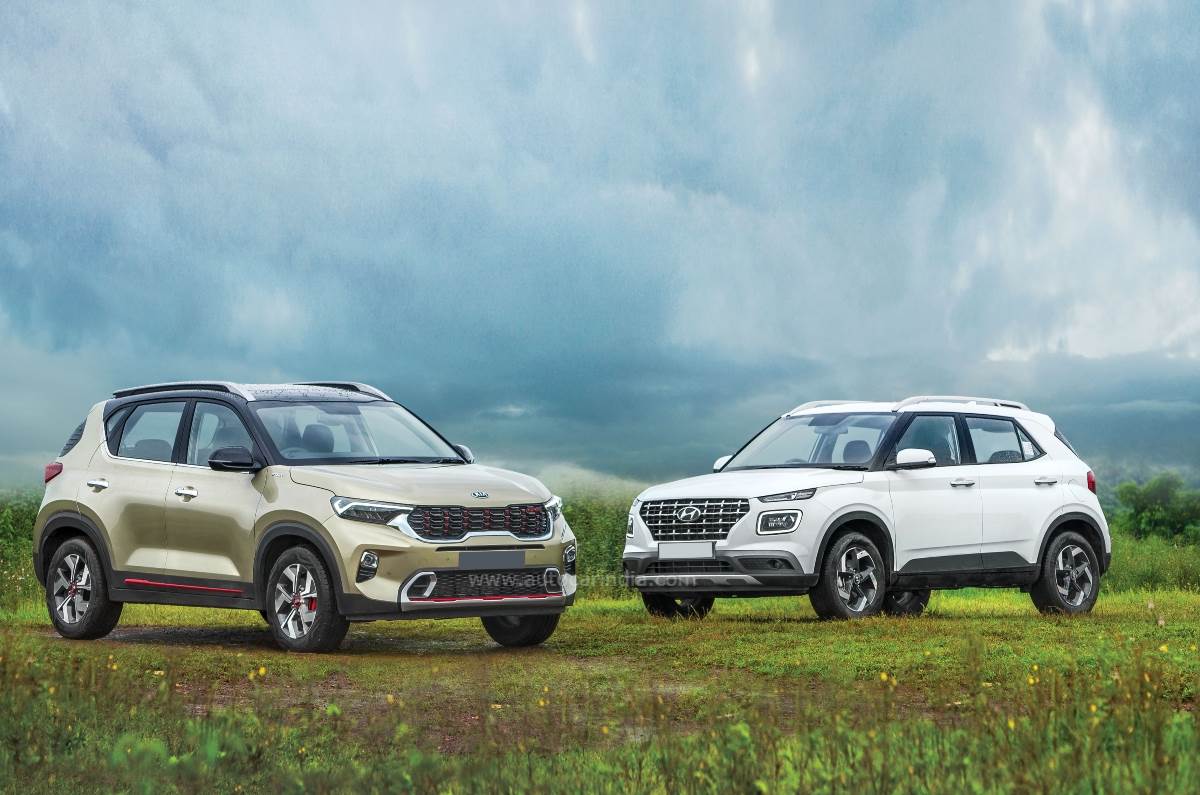
Mahindra Bolero
Originally introduced as the Bolero Power Plus – with trimmed bumpers shrinking it under four metres and equipped with a 1.5 diesel engine – Mahindra cleverly ensured this venerable workhorse classified as a compact SUV, benefitting from a lower tax bracket. Going by the prices, the Bolero today is the cheapest compact SUV you can buy, but its rudimentary approach with no frills will only appeal to buyers looking for a reliable workhorse. Sources tell us that demand for used Boleros is far stronger in rural and semi-urban regions of the country. In metros, where this study is conducted, buyers are looking for modern and feature-laden alternatives, hence the Bolero seems to depreciate at a greater rate than other compact SUVs.
Mahindra XUV300
The XUV300 is one of the priciest compact SUVs in its class and it is also the one that depreciates the fastest in the used car market, thus making it a better pre- owned buy. It is spacious, has plenty of powertrain options and is packed to the gills with safety features, however, limited boot space and dated interiors remain deterrents for buyers shopping in this space. It must be noted that there was no petrol-AMT data, and because the car sold in relatively limited numbers to begin with, used examples aren’t available in abundance like its rivals.
Maruti Suzuki Brezza
After dominating the sales charts with its sole-diesel engine, the Brezza became petrol-only from 2020. What’s interesting is that, at 21.3 and 32.2 percent depreciation for two-year-old petrol manual and automatic iterations, respectively, the Brezza still holds its value rather well compared to most of its rivals.
Tata Nexon
The Nexon caught the fancy of buyers for its styling and value proposition. Over the years, Tata has been upping the Nexon’s premium quotient by introducing upmarket features and automatic (AMT) options. As a result, its prices have kept rising steadily. Five-year-old petrol examples go for below Rs 5 lakh, making it among the cheapest compact SUVs you can buy in the pre-owned market. What’s interesting is that average prices of three- and four-year-old AMT versions are similar, irrespective of whether they are petrol or diesel.
Toyota Urban Cruiser
Toyota’s equivalent of the Maruti Brezza seems to be doing an even better job in the used car space, commanding a heavier premium. Being mechanically identical to the Maruti only seems to indicate that the lure of the Toyota badge seems to be the reason why buyers are paying higher prices to buy the Urban Cruiser.
Midsize SUVs
Since last year, the midsize SUV segment witnessed the entry of several new players like the Volkswagen Taigun, Skoda Kushaq, MG Astor, Maruti Grand Vitara and Toyota Urban Cruiser Hyryder. However, the cars we have taken into consideration for this used car study are the Hyundai Creta, Kia Seltos, Nissan Kicks and the Mahindra Scorpio, which have been on sale for two to five years. The Renault Duster and Maruti Suzuki S-Cross, which were a part of our study last year, have now been discontinued, and are thus not a part of it this time around.

Hyundai Creta
The Creta is a car that appeals to a broad set of buyers, and spread across a wide price band with multiple engine-transmission options, it isn’t a surprise that this Hyundai is dominating the sales charts. Hyundai did lose to the Seltos in 2019, however, with the arrival of the all-new Creta, the tides turned back in favour of Hyundai. The used car data reveals a rather interesting trend, wherein the petrol-manual variants are being sold for higher prices than the diesel manual in some cases, even though the latter are far pricier to begin with. Also, automatics seem to be holding their value better than their manual counterparts. As far as the new-generation Creta goes, due to strong demand and a long waiting period, it is the slowest to depreciate in this segment.
Kia Seltos
Kia rocked the market with the introduction of the Seltos in 2019, and with multiple price hikes, the used car data last year also revealed that some cars were changing hands at prices higher than the original on-road price. A similar trend can be witnessed for the MY20 diesel-automatic variants this year, where the average resale price is higher than their original on-road price. This could also indicate that a chunk of the diesel-automatics sold are top variants, which have seen larger price hikes, and not the mid-spec. Like the Creta, the Seltos, too, witnesses a strong demand in the new car market, due to which used car demand is rather strong.

Demand for the Kia Seltos and Hyundai Creta is strong in the new and used car market alike.
Mahindra Scorpio
What’s interesting is that the average new car on-road price of a Mahindra Scorpio has risen from Rs 14.73 lakh in 2017 to Rs 17.63 lakh in 2020. That, however, hasn’t dissuaded buyers from buying the Scorpio, either brand-new or used. Four- and five-year-old examples depreciate about 42 percent and can be had for about Rs 9 lakh and Rs 8.4 lakh, respectively, while newer ones go for Rs 11 lakh-13.7 lakh.
Nissan Kicks
Once known for its strong diesel engine, with the advent of BS6 in 2020, the Kicks line-up became petrol-only and had only a 1.5-litre petrol and a 1.3-litre turbo-petrol on offer. Neither of these engines could propel sales of this Nissan SUV, and its performance in the used car space is also equally disappointing. Two-year-old cars depreciate as much as 40 percent and can be had for under Rs 8 lakh, while MY19 cars are exchanging hands for under Rs 7 lakh.
Executive SUVs
While both the Volkswagen Tiguan and Skoda Kodiaq qualify for this study, due to inadequate data of used examples, these have been left out. Also, because Honda has discontinued the CR-V and Mahindra the XUV500, these don’t feature in the current list either.
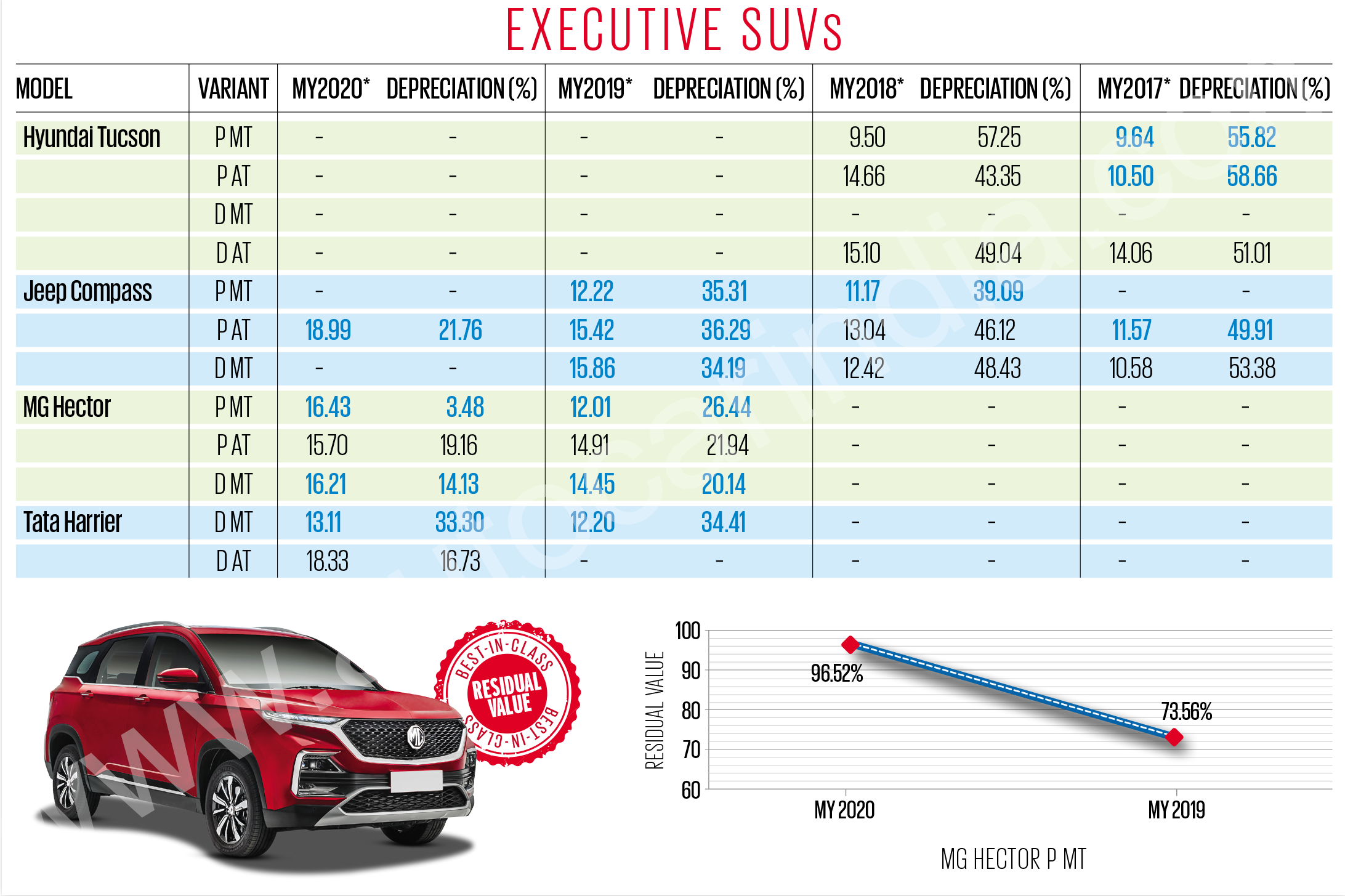
Hyundai Tucson
Launched in 2017, the Tucson is Hyundai’s flagship SUV in India, and was available with petrol and diesel engines with manual and automatic transmissions, and an all-wheel-drive option too. Five-year-old examples are available at less than half of the new car’s price from 2017, with petrol variants depreciating the most. Diesel-automatic variants hold their value a bit better, however, there is no data available for diesel-manual variants.
Jeep Compass
Jeep has been rather consistent with its average new car prices, especially after new entrants like Tata Harrier and MG Hector undercut its pricing by a significant margin and are larger in size and offer better value. Interestingly, in the used car market, this American SUV depreciates slower than the Tucson.

Tata Harrier, Jeep Compass depreciate faster than MG Hector.
MG Hector
Hector’s stellar value proposition has positively impacted demand and waiting periods have swelled ever since its launch. The impact of this favourable response in the new car market is reflected in used car prices as well, and the Hector is the slowest depreciating executive SUV, so buyers lose the least if they sell their MG in two or three years compared to any other brand.
Tata Harrier
The Harrier was Tata’s flagship SUV till it passed the baton to the Safari in 2021. Its stylish exteriors, spacious interior and its tough build helped ensure sales were strong, despite being a diesel-only offering. Demand for the diesel-manual in the second-hand market isn’t as strong and it loses a third of its value in just two years. The diesel-automatic, however, seems to hold its value rather well, depreciating merely 16.73 percent in two years.
MPVs
Unlike other segments, MPVs in the market are scattered across various price points, hence this segment isn’t sub-divided by price, and is presented as a compilation of all the offerings on sale, starting with the Renault Triber that has an average on-road price of Rs 7.10 lakh, going all the way up to the most expensive Toyota Innova Crysta averaging Rs 25.59 lakh. The Kia Carnival that was introduced in 2020 hasn’t changed hands in any meaningful volume, and hence, has been left out of this study.

Mahindra Marazzo
Mahindra’s diesel-powered Marazzo hasn’t lit up the sales charts. In the used car market though, the Marazzo comes across as an excellent buy, provided you can find one, as it depreciates the most and four-, three- and two-year-old examples can be had for under Rs 7 lakh, under Rs 8 lakh and around Rs 9 lakh, respectively, making it more affordable than a similarly aged Maruti.
Maruti Suzuki Ertiga
Like the Innova, the Ertiga is known for its reliability and practicality, but unlike the Toyota, the Maruti is priced much lower, hence has larger volumes. Prices for the second-generation Ertiga went up significantly and used car prices of this generation seem to be much higher than the older generation, showing the lowest depreciation among MPVs. The CNG variant seems to be holding its value the best. For reference, two-year-old CNG examples depreciate merely 8 percent, whereas three-year-old examples lose merely 13.9 percent.
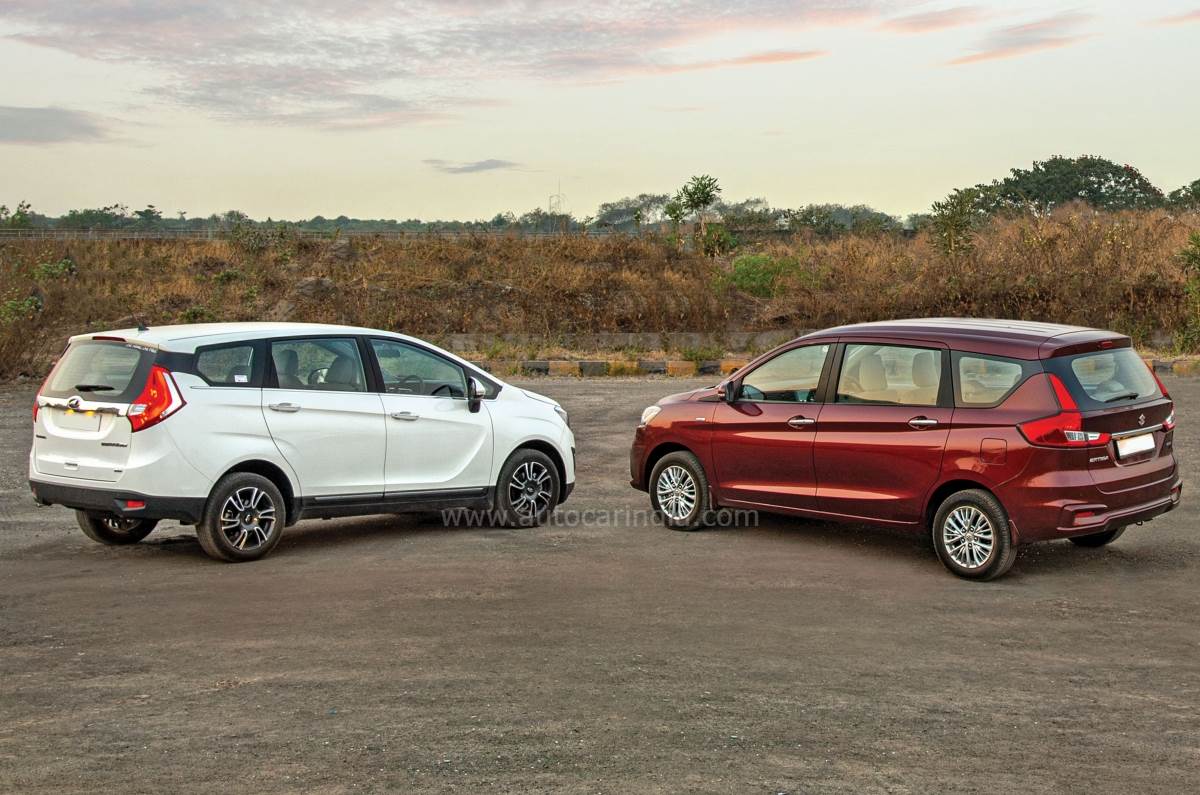
Marazzo’s high depreciation makes it cheaper than a used Maruti Ertiga.
Maruti Suzuki XL6
Being the more premium version of the Ertiga, the XL6 commands a higher average price in the pre-owned segment as well. As is the case with the Ertiga, buyers are paying nearly Rs 1 lakh more for the automatic over the manual variants.
Renault Triber
The Renault Triber is the most affordable 7-seater and because of its clever packaging, it has a surprisingly spacious cabin. The company introduced the car with a sole-petrol engine, and in 2020, it also introduced an automated manual transmission option. Two- and three-year-old examples still command nearly three-fourth of their average asking price.
Toyota Innova Crysta
Having built a formidable reputation for dependability, the Toyota Innova Crysta is also a very comfortable people-mover. Being a workhorse too, owners generally tend to hold on to their Innovas for a long period, and it is this reason why there are very few two- and three-year-old examples in the used car market. Also, for a car that costs upwards of Rs 20 lakh on road, the Innova holds its value rather well.
Also see:
Tier II cities drive used car sales: OLX-CRISIL study
Used car market to grow to 7 million units by 2026: OLX Autos
























